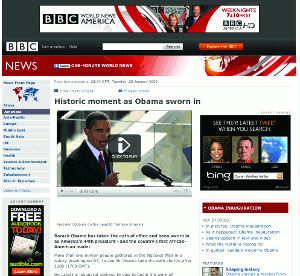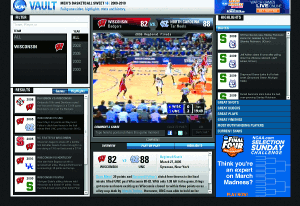The Economics of Live Events
Production Equipment: BYOC?
I also asked a question regarding the use of cameras and production equipment, to see whether cameras are set up specifically for a high-profile webcast or whether equipment provided by the venue is used. This was also asked partly as a way to gauge whether the service providers offered production capabilities or just passed them along.
"The events we do are split evenly between our cameras and the customers' equipment," said Patrick Holloway, executive producer for NetStreamLive, noting that the majority of events his company does is not open to the public.
"None of our events are for broadcast," said Holloway, "but we are also a Wireless ISP (WISP), so we also provide dedicated connectivity to the venue alongside production equipment."
Smith said that fixed cameras-both venue cameras and broadcast cameras-were used as he worked large-scale events, but there were times that on-site cameras were set up specifically for an event.
"When Howard Stern made his transition from terrestrial radio to satellite," said Smith, "we carried his parade through New York City live, and cameras were set up at various points along the path: at his studio, along the streets outside, in the open-topped bus he travelled in and, finally, at the Hard Rock Cafe. Once he entered the Hard Rock Cafe, there were fixed cameras there that we leveraged as well."
Most CDNs also don't use event-specific cameras, relying instead on the broadcast feed. But Level 3 is one of the few in a unique position to handle the feed both pre- and post-broadcast.
"We do not do any on-site production, though we do sometimes have on-site support for the very largest events involving multiple broadcasters," said Neill. "Many times we are already providing the connectivity from an event location back to a broadcaster's master control using the Vyvx network," Level 3's dedicated data line that delivers broadcast-quality signals from events such as the Super Bowl.
"It is easy for us to replicate that feed and send it to a streaming encoder for internet delivery either live or stored for a later VOD delivery," said Neill. "A third source is via our four teleports. Whereas the first two sources are the very high-quality, pre-broadcast feed, the teleports allow us to pick up post broadcast signals from satellites covering Europe, North America, and the Pacific."
So how do production costs fit into total acquisition and distribution cost? Smith says that most events, since they already have cameras in place, are only an incremental cost of the total delivered cost.
"Unless you're talking about carrying off an event with 6-8 cameras with a lot of production elements, this isn't your largest cost," said Smith. "While production is still a cost to be managed and contained with these operations, I think the largest concern and area of focus fall around the content, monetization strategy, and cost to bear the bit transfer."
Smith did, however, say that in-venue costs are something that an agency needs to think about, especially when it comes to point of origin for the live stream.
"A service bureau can easily get sideways with cost on a webcast when they don't understand the cost incurred to replicate a broadcast online," said Smith. "The bureau or production team must consider this, as well as understanding how to originate, as bandwidth drops at a venue are often overlooked or underestimated. Add to this digital signal acquisition or capture costs to distribute webcasts to the CDN, as well as the potential interest in the event for peak or aggregate simultaneous viewers, versus the potential for monetization."
Does Size Matter?
This leads directly into another question I asked centered on the "sweet spot" of bit delivery, in terms of the number of simultaneous viewers and bitrate costs. I asked the respondents to give their insights into the following breakdown of simultaneous viewers:
 • Up to 50,000
• Up to 50,000
• 50,000-100,000
• 100,000-1 million
• 1 million-5 million
For Holloway and NetStreamLive, which focuses on a number of nonbroadcast events at the lower end of the range, the most costly part of the whole event is the hosting.
"For internal communications events, at any level, it is the hosting," said Holloway. "Unfortunately, it may be a waste catering to the higher bitrates until the price of bandwidth drops significantly. At this point, for some of our larger corporate events, it is still about the audio delivery."
Smith sees the sweet spot at about 50,000 viewers, where the costs of the event-including production, equipment rental, and setup-are front-end loaded but not offset by a large-enough audience to fully cover a free-to-air model.
"North of 50,000 viewers," Smith added, "I think the largest cost barrier is the bandwidth and expense of moving the bits. As you pass the 100,000 viewer threshold and above, your aggregate cost per bit transferred may be less than at lower traffic levels, but you are spending a significant amount of money to offer an event, and [you] should have a monetization strategy to offset those costs and/or profit from having offered the event."
Level 3 concurs. "At the higher levels of concurrent viewers, the cost of the delivery becomes the dominant factor," said Neill. "At fewer concurrent users, the production costs start to dominate, and the delivery costs are diminished. The duration of the event also has a big impact: Streaming the Olympics is a very different proposition to streaming Michael Jackson's memorial service. The former lasts 2 weeks, with multiple individual events, while the latter has a huge number of viewers but is all over in a short period of time."
One recurring theme was the cost of setup as an impact on the overall cost of the event-and not just the cost of standard equipment setups.
"The biggest waste of resources comes from the fact that there is no standard way of delivering a live internet stream," said Taylor. "They are all bespoke, unique, and different. From an op-ex perspective, both for us and our customers, that is not as efficient as it could be. Contrast that to Vyvx where we can do near real-time turn-up with little notice. It is simple and automated to a very high degree, and customers also know that they can call us and get connected within minutes, so less planning is needed. The industry for internet streaming needs to develop in the same way."
Where Do We Stand?
At the outset, I mentioned that this is a brief overview of the general state of live event streaming. Beyond additional research and emerging technologies, though, are there any trends to spot?
The answer appears to be yes since the number of large-scale live events being simulcast on the web and on traditional television or cable is growing. For many broadcasters, offering a live component of something being traditionally broadcast is an extension of their brand and is now a necessity.
Within that trend, there is also a trend to offer exclusive live content on the web.
"There is a growing trend toward offering more camera angles and additional content from an event venue that speaks to making a live event more interesting," said Smith, noting an ongoing example in the Olympic Games in Vancouver, as well as the ever-popular Sunday Night Football.
In the end, determining a return on investment will often be driven by a few key data points: popularity (or exclusivity) of content; a balance between free-to-air, subscription, or pay-per-view revenue models; and the total cost of offering the event online versus traditional broadcast methods.
"The broadcaster is willing to incur slightly larger costs to provide additional content to make the user more the programmer, but with a keen eye toward offsetting or capitalizing on the cost of those extra feeds," said Smith. "Helping them realize how to monetize that content is imperative in the near term."